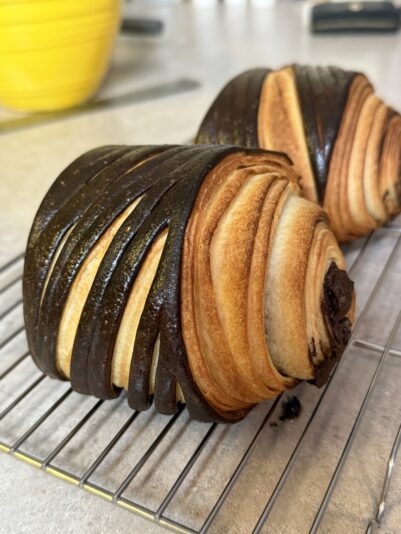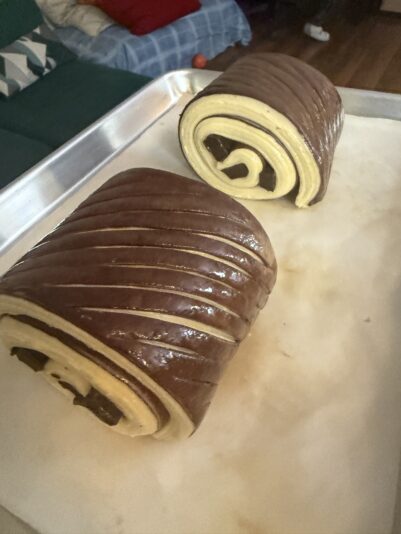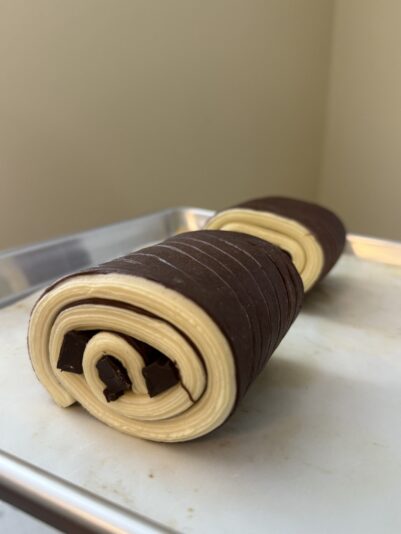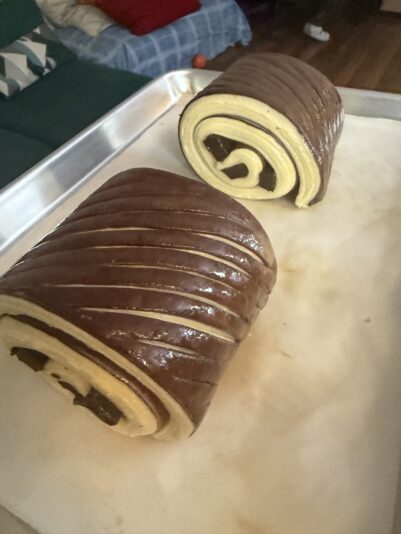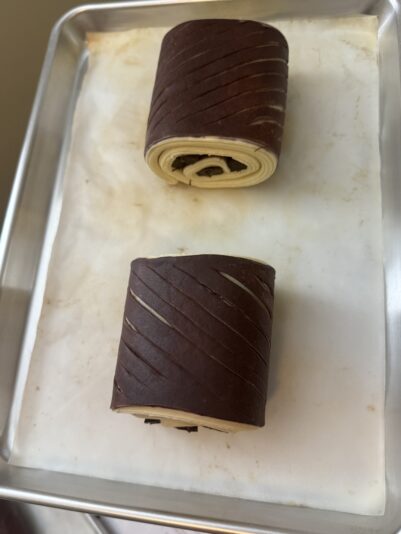Scoolinary › Forums › Ask a question › Pano Chocolate croissant failed
-
Pano Chocolate croissant failed
Escrito por Salma Sali on octubre 11, 2024 en 05:45My layers showed up but no flaky consistency. Not crispy but hard top 🙈 Based on these images where do you see my problem?
Sussan ScoolinaryTeam respondió hace 1 mes, 1 semana 2 Miembros · 4 Respuestas -
4 Respuestas
-
Forgot to mention I made these croissants per recipe of chef Antonio Brochur and I also found that the dough turned out very tough not like in the video after he used that dough machine so his dough was pretty pliable, mine was end up being very tough and since my mixer wasn’t able to handle it even for 5 min of mixing it I had to do it manually, constantly putting dough in the freezer to maintain the temperature under 24 Celsius. Rolling out such dough was extremely painful for me so I spent the whole day just for rolling it out 🙈😂 so anyways I tried my best but after I formed croissants that looked for me amazing but indeed those also got melted, to be specific the butter got melted… any suggestions?
-
Hi Salma.
We now that making croissants is not an easy task and requires a lot of practice to master the technique.
From the photos you shared, one of the reasons could be that you didn’t laminate correctly; the layers of butter and dough may not have been well distributed, affecting the formation of the flaky layers. On the other hand, if you over-laminate, you can break the layers and lose the flakiness.
Another important point is the baking process. The oven should be preheated for about 20 to 30 minutes before baking the croissants. An oven that is too hot can harden the top before the inner layers are properly cooked, resulting in a raw or dense texture.
Regarding the butter leaking out of the croissant during baking, there could be several reasons:
-Butter temperature: If it’s not cold and firm, it melts quickly.
-Excessive fermentation: This makes the layers fragile, allowing the butter to escape.
-Poorly preheated oven: An oven that isn’t hot enough doesn’t cook the dough quickly, allowing the butter to melt.
-Incorrect lamination: If the butter isn’t well distributed or breaks, it can melt during baking.
To avoid this, make sure to work with cold butter, control the fermentation, and bake at the right temperature.
In response to your question about the texture of the dough, this recipe works best when prepared in a mixer with the capacity and strength shown by the chef. If done by hand, the kneading times will be different; remember that the dough heats up when in contact with your hands, causing it to lose moisture and elasticity. For next time, if you’re going to prepare the dough by hand, you can increase the liquid by 10% and knead in intervals of 3 minutes, allowing it to rest for 1 to 2 minutes to avoid overheating the dough.
Reviewing these points could help you identify the problem.
Best regards.
-
Hi Sussan,
Thank you for your reply.
I actually followed the most if not all the bull points that you have mentioned, however I suspect that the fermentation part was failing as I went through the other members”s issues here in chats, I’ve learned that most of them stating of prodding in cooler environment, meaning that in my case as I did put my croissants into the oven with setting being off, uncovered, put a small glass of boiled/hot water for generating humidity and the temperature was showing sometimes 26 Celsius, but maybe this time it was higher I don’t know. in 2 1/2hrs the croissants looked amazing for me 😜 maybe I’m wrong I don’t know… and oven was preheated but as you said probably it was overheated…I have the oven thermometer though, and it was showing 170 Celsius, mhm… You still think it’s a lamination process ? However, if you look at these pictures you’d be able to see distinctive layers,no?
-
-
Hi Salma.
Correct, now I see that your layers are well laminated. In this case, it might possibly be the oven temperature.
Every oven is different and works in various ways. As I mentioned earlier, making croissants is a technique that is mastered with a lot of practice, not only in terms of timing, fermentation, and lamination, but also in getting to know your oven perfectly and understanding the ideal temperature and time for baking.
Remember that the time and temperature indicated in a recipe are relative; many factors can cause them to change, such as the brand of the oven, the size of the oven, the size of the croissant, etc.
These are several factors that you will master with time and practice. If you have any other questions, feel free to ask; I’m here to help.
If you need anything else, just let me know!
Log in to reply.



